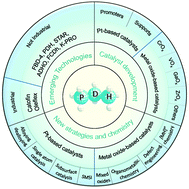Propane dehydrogenation: catalyst development, new chemistry, and emerging technologies
Abstract
Propylene is an important building block for enormous petrochemicals including polypropylene, propylene oxide, acrylonitrile and so forth. Propane dehydrogenation (PDH) is an industrial technology for direct propylene production which has received extensive attention in recent years. With the development of dehydrogenation technologies, the efficient adsorption/activation of propane and subsequential desorption of propylene on the surfaces of heterogeneous catalysts remain scientifically challenging. This review describes recent advances in the fundamental understandings of the PDH process in terms of emerging technologies, catalyst development and new chemistry in regulating the catalyst structures and inhibiting the catalyst deactivation. The active sites, reaction pathways and deactivation mechanisms of PDH over metals and metal oxides as well as their dependent factors are also analysed and discussed, which is expected to enable efficient catalyst design for minimizing the reaction barriers and controlling the selectivity towards propylene. The challenges and perspectives of PDH over heterogeneous catalysts are also proposed for further development.

- This article is part of the themed collection: Recent Advances in Alkane Conversion


 Please wait while we load your content...
Please wait while we load your content...